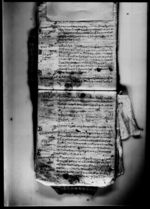A copy of a lālamohara from King Rājendra appointing Pratāpanātha as priest of Śrī Ratannātha at Phalabang (VS 1879)
ID: K_0014_0009A
Edited and
translated by Christof Zotter
Created: 2021-10-12;
Last modified: 2022-03-01
For the metadata of the document, click here
The accompanying edition, translation/synopsis and/or commentary are available under the terms of the Creative Commons Attribution-ShareAlike 4.0 International License
Abstract
In the original of which this document is a copy, the king, who according to the date must have been Rājendra, appoints Pratāpanātha to perform the regular and occasional worship of Śrī Ratannātha at Phalabang.Diplomatic edition
[1r]
1२०१1पो१५पा५३सी२६६12हे•नौ•राम
3 ¯¯¯¯¯¯¯¯¯¯¯¯1आगेप्रतापनाथकेफलावाङ्•कारतननाथकोगुठी•लक्ष्मीनाथका
2नाऊकोमोहर•हानी•वक्सौपरापुर्वकारीतलेनीत्यनैमीत्यपुजामा
3रुजुरहीहाम्रोजये़मनाईपुजामालग्याकोलाईसेषरह्याकोलीआ
4फ्नाषातीरज्मासीतगुठजानीभोग्यगरईतीसम्वत१८७९सालभ
5द्रवदी३०रोज शुभं¯¯¯¯¯¯¯¯¯¯¯¯¯¯
Translation
[1r]
[in the left margin:]
2011
Bundle (po[kā]) 15, pā 53, sī 2662
[Concerning a] pūjāguṭhī3
The one who said (bhaṃ. for bhaṃne) [was] the clerk (nau for nausindā)Harṣa
The one who watched (he. for herne) [was] the clerk Rāma4
[main text:]
Āge: to Pratāpanātha
We have annulled the mohara [regarding] the guṭhī of Ratannātha (text: Ratana°) of Phalabang (text: Phalāvāṅ) [that was issued] in the name of Lakṣmīnātha5 [and] granted [you the following rights]: As [was] the earlier custom, be present for the regular and occasional worship, celebrate our triumphs, [be] conscious of your duty, conceive the guṭha [as yours], take what remains after covering worship [expenditures], [and] enjoy [the attendant fruits].
[Saturday,] the 30th of the dark fortnight of the month of Bhādra, in the [Vikrama] era year 1879 (1822 CE).6 Auspiciousness.7
Commentary
According to Nārāyaṇanātha's Rājaguruyogīvaṃśāvalī (Naraharinātha n.d.: 69) Pratāpanātha was a disciple of the former pūjārīVuṭinātha. After some problems with an alliance between foreign yogīs and local officials (amālī) who "apparently spoiled and ruined the shrine by annually conducting a pajanī" (pardesi jogī ra amālī mīlī varṣa prati pajanī gardā thāna bīgrana ujrana gayecha) Pratāpanātha was re-appointed as pūjārī in VS 1884 (see K_0636_0013; Naraharinātha VS 2022: 494). In VS 1891, the office was assigned to his disciple (cf. Naraharinātha n.d.: 69) Brahmanātha (K_0013_0048A and K_0636_0012), who later on faced problems similar to what his guru had with the foreign yogīs (see K_0008_0032A and K_0636_0010).8

